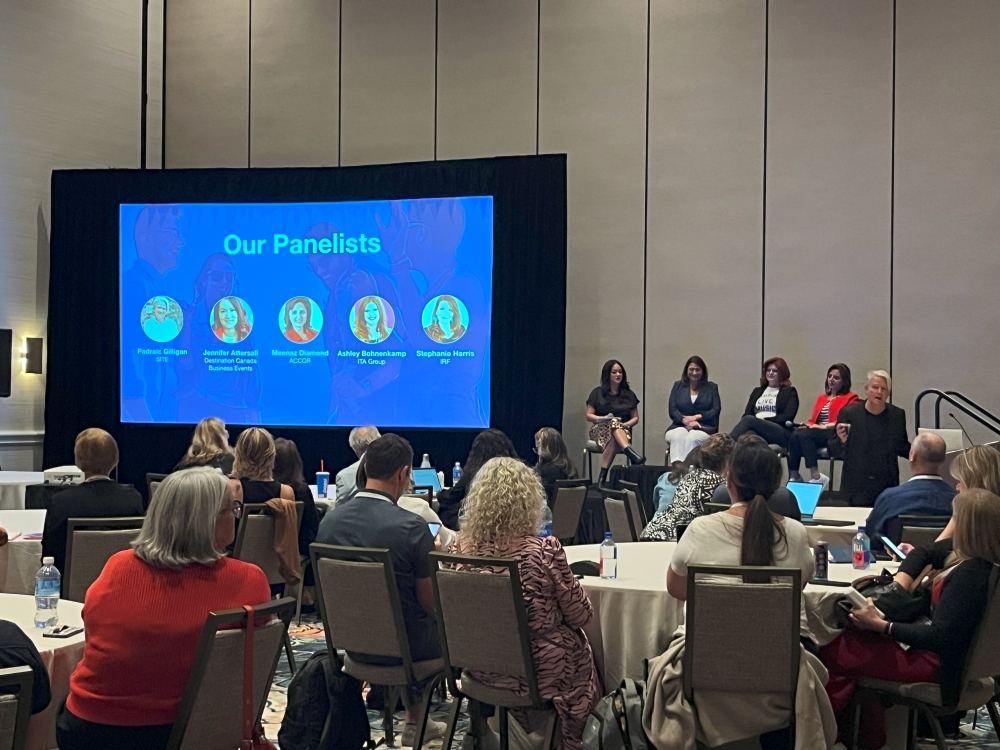The leading annual survey of incentive travel buyers and sellers, released at IMEX America 2023, paints a pretty picture for the segment, with a particularly strong showing regarding the consideration of lesser-traveled locales.
For the past five years, the Incentive Research Foundation (IRF) and Society for Incentive Travel Excellence (SITE) have come together in a joint initiative to produce “the business events industry’s most authoritative study of the global incentive travel market and its impact on corporations, agencies and the supply chain in destinations,” better known as the Incentive Travel Index (ITI).
This study, undertaken in partnership with independent economic advisory firm Oxford Economics, serves both as a “historical snapshot” of where the incentive industry has been and a “predictive hypothesis” of the direction its heading, according to ITI’s website—and 2023 survey highlights have just been released.
During IMEX’s Smart Monday powered by MPI, SITE Chief Marketing Officer Pádraic Gilligan took to the stage to moderate a panel discussion breaking down the data. Panelists Jennifer Attersall of Destination Canada, Meenaz Diamond of ACCOR, Ashley Bohnenkamp of ITA Group and Stephanie Harris, president of IRF, shared their thoughts from various industry perspectives.
[Related: SITE's Pádraic Gilligan Talks New Incentive Travel Index]
Here’s a look into the themes and takeaways of this year’s 2023 Incentive Travel Index.
Breaking Down This Year’s Incentive Travel Index Responses
This year’s ITI saw the biggest response yet, with a total of 2,464 survey respondents and 1,648 complete survey responses—a 64% increase over 2022, according to Gilligan.
Agency and corporate buyers comprised 38% of respondents, while destination suppliers made up 33% and DMCs comprised 25%. North Americans made up just under half of respondents, 20% came from Europe and the remainder was split between Asia Pacific, Latin America, Central America, the Caribbean and Mexico, and the Middle East and Africa.
IRF, SITE and Oxford Economics also introduced new lines of inquiry into the survey, touching on channel relationships and working together, general industry shifts and more, while keeping perennials surrounding the purpose of incentive travel, destination selection and headwinds and challenges.
During MPI’s Smart Monday launch of the Incentive Travel Index and discussion, panelists broke down the report’s results into four selected topics and themes: The Purpose of Incentive Travel; Growth, Budgets and Spending; Channel Relationships; and Destination Selection. Following is a breakdown of results across all four.
The Purpose of Incentive Travel

“Incentive travel’s primary purpose has always been around growth in sales, revenues, profitability, with its business model centered around incentive programs paying for themselves out of the uplift,” Gilligan said during the panel discussion. “So, ROI has always been the key consideration.”
Recently, though, Gilligan said there’s been an increase in companies focusing more on the “unintended consequences” of incentive travel, or the intangible benefits like improved relationships, better communication and a stronger workplace culture, and 68% of this year’s ITI survey responses agree. However, hard-power benefits like increased sales remain the most important factor for using incentive travel in North America (42%) and Western Europe (38%).
Two-thirds of survey responses agree that company executives are increasingly recognizing that incentive travel is a key part of future workforce strategy, and while it was previously used to motivate individual performance, incentive travel is now being seen as a tool to bring companies together—literally and figuratively.
When considering the shift to remote and hybrid work in recent years, 81% of respondents agree incentive travel plays an even more important role in building engagement and creating face-to-face opportunities to connect, and 90% cited retention of employees as the most common reason why incentive travel is gaining strategic importance.
“This hard power versus soft power thing is a bit of a pendulum. It goes back and forth,” Gilligan said. “When the economy is good and corporations are making money, they become focused on the wider purpose of why they exist. Corporations are not talking about profit, and planet and people, which is a much more holistic way of running a business.”
[Related: 2022 International Incentive Travel Destination Comeback]
Growth, Budgets and Spending
The ITI makes a distinction between growth in participation and growth in per capita spend, and this year’s results show an increasing gap between the growth in qualifiers and the growth in budgets to pay for them. While the number of qualifiers increases, budgets just don’t budge.
“[The future of incentive travel spend] is going to be tricky,” Gilligan said. “We could see it in the figures for 2024. There wasn’t the same sort of unbridled optimism, whereas 2025 was back to the sort of levels that we would have had in 2019.
“The danger is that we kind of unleash the power of incentives by extending the number of qualifiers,” Gilligan continued. “We don’t actually unleash the power of the purse strings.”
Channel Relationships
This year’s ITI gave respondents nine words to choose from to describe the state of incentive travel relationships between buyers and suppliers. More than half of respondents described current channel relationships as “complex,” and following close behind are descriptors like “challenging” and “uncertain.”
“It was very interesting, [during the panel] when we referred to the SITE Young Leaders Conference that most of us had attended the previous day,” Gilligan said. “One of the comments that came out of the room was a younger professional felt a little bit limited in the organization that he was working in because he was expected to work with partners that the particular organization had worked with for 20 or 30 years.
“He felt those partners weren’t going to be able to deliver the kind of vision that he had as a younger professional for the type of programs that they would like to do, and I thought that was a very telling comment,” he continued. “We are a loyal industry; we tend to continue to work with the people that we have learned to trust over a period of time, and that’s hugely important. But what the young leader was saying was, ‘Those aren’t my relationships. Those are my boss’ relationships, and I want to make my own 20-year relationships starting now.’”
Destination Selection
Growing increasingly more important are new destinations that have never been used before (71%), with all-inclusive resorts following close behind at 53%. Cruises are back in the game, too, following a hard hit due to the pandemic, and some of the top destinations currently being considered include Canada at No. 1, Alaska, cruises and Hawaiʻi.
“The most interesting thing from this part of the research for me was the fact that destinations that you haven’t been to before are the types of destinations we want to go to,” Gilligan said. “I think it kind of opens the door for all those second-, third-, fourth-, even fifth-tier destinations that all have something very special but wouldn’t in the past have been identified necessarily as being incentive quality, and it’s wonderful to see that we’re now looking beyond that.”
To learn more and see more of this year’s ITI results, visit www.incentiveindex.com, or get the report directly through SITE Global at www.siteglobal.com.
Read this next: Internal Meetings, AI to Drive Meetings and Events Industry Growth in 2024







